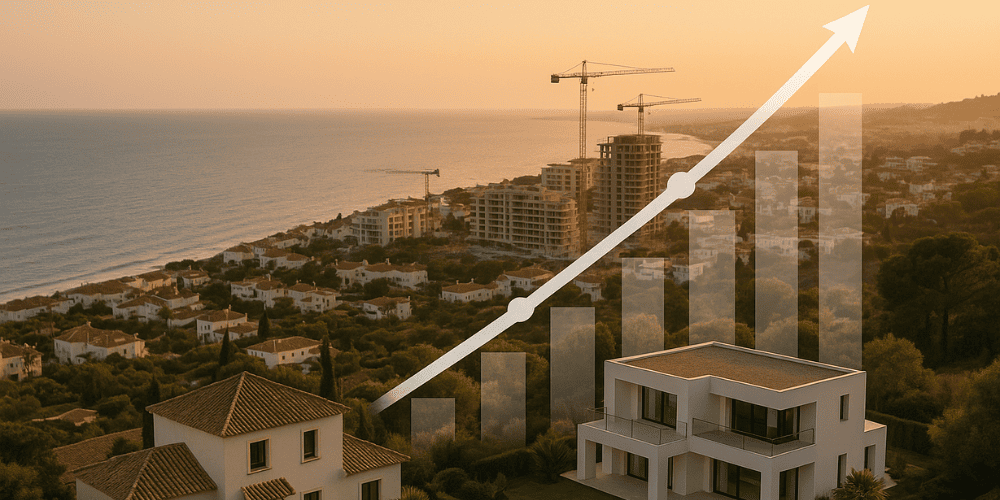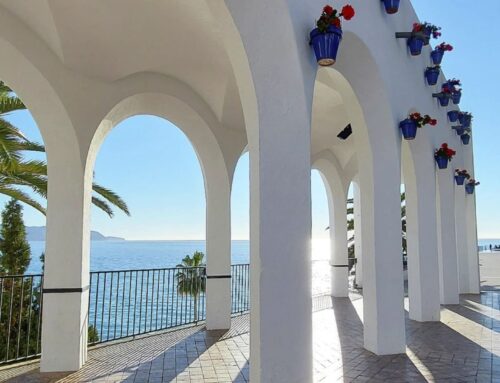Residential Real Estate Market Overview – Costa del Sol (Málaga, Benalmádena, Fuengirola, Mijas, Marbella, Estepona, Casares)

Author: Eve Keerus-Jusupov, CEO of Merlis Homes SL.
Helping you navigate Costa del Sol property with confidence and peace of mind.
Have a question? Contact me via WhatsApp
1. Price dynamics (2022–2024)
Sale prices (€/m²)
Across all observed areas (Málaga, Benalmádena, Fuengirola, Mijas, Marbella, Estepona, Casares), the average residential price per square metre increased significantly between 2022 and 2024. The table below summarises the average asking prices per m² at the end of each year.
| Area | 2022 (€/m²) | 2023 (€/m²) | 2024 (€/m²) | Change 2022–2023 | Change 2023–2024 |
| Málaga | approx. 2,338 | approx. 2,668 | approx. 3,241 | +14% | +21% |
| Marbella | approx. 3,978 | approx. 4,461 | approx. 5,050 | +12% | +13% |
| Benalmádena | approx. 2,669 | approx. 3,009 | approx. 3,538 | +13% | +18% |
| Fuengirola | approx. 2,860 | approx. 3,195 | approx. 3,814 | +12% | +19% |
| Mijas | approx. 2,448 | approx. 2,758 | approx. 3,149 | +13% | +14% |
| Estepona | approx. 2,891 | approx. 3,256 | approx. 3,681 | +13% | +13% |
| Casares | approx. 2,356 | approx. 2,346 | approx. 2,845 | –0.4% | +21% |
As seen above, prices rose faster in 2023–2024, especially in Málaga (+21%) and several other coastal towns. Only in Casares did prices stagnate in 2023 compared to the previous year, but then jumped sharply in 2024.
Number of transactions
Following the pandemic, the Costa del Sol experienced an unprecedented surge in buying activity. The year 2022 became the most active sales year on record – a true “demand avalanche.” Both local and national transaction records were broken. In the “Golden Triangle” area of Marbella–Estepona–Benahavís, **10,381 residential properties** were sold in 2022, marking an all-time high.
In 2023, the market began to normalise: sales in the Golden Triangle dropped by around 20% (from 10,381 to 8,273 transactions) compared to the extraordinary levels of 2022. Nevertheless, 2023 remained a very strong year — transaction volumes still exceeded pre-2019 figures, meaning the market “shifted from exceptionally high activity to simply very high activity.”
In 2024, sales volumes increased again. The number of transactions in the Golden Triangle rose by approximately 5.2% year-on-year. In total, 8,706 residential properties were sold across Marbella, Estepona, and Benahavís (including 1,187 new homes), showing a renewed upward trend approaching the record levels of 2022.
Rental prices
Over the past three years, rental prices across the Costa del Sol’s popular areas have risen sharply, driven by both increasing property values and strong demand. By the end of 2024, nearly all municipalities exceeded the threshold of **€10/m² per month**. Marbella recorded the highest long-term rental average at approximately **€17.6/m²** (December 2024), up **8.8%** year-on-year.
Estepona averaged €16.6/m², and Benahavís €16.0/m².
Torremolinos and Benalmádena exceeded €15/m², while Málaga city stood around €14.2/m².
Fuengirola averaged €13.9/m², and Mijas €13.2/m².
Among the most affordable areas was Casares, at around €10.7/m².
(For comparison, Spain’s national average rent at the end of 2024 was €13.3/m².)
Rental yields are therefore highest in mid-priced areas – for example, Estepona yields around 5–5.5% annually (rent ≈ €16.6/m² vs price ≈ €3,681/m²) – whereas in luxury markets like Marbella, returns are lower (≈ 4–4.5%) due to the high purchase price level.
Liquidity
Market liquidity was illustrated by the fast sales pace in 2022 – due to limited supply and abundant demand, many properties sold quickly. During 2023–2024, liquidity remained solid, though activity gradually stabilised.
Across the Costa del Sol, the average time to sell a property is under six months, indicating a continuously active market.
In Marbella’s luxury segment, around 90% of buyers purchased without mortgage financing in 2022–2023, meaning interest rate increases had little impact on the pace of sales.
Conversely, in local-buyer-driven markets (e.g. Málaga city), rising interest rates in 2023 slightly cooled the previous “sell-within-days” dynamic.
In the second half of 2024, demand stayed strong while available inventory decreased.
For example, Marbella’s supply of listings fell by around 9% from Q2 2023 to Q2 2024 (and by –18% in East Marbella), further increasing price pressure.
Overall, between 2022 and 2024, market liquidity remained very healthy: transactions were concluded swiftly, and supply consistently lagged behind demand.

2. Current market situation – Autumn 2025
Price level and trend
In autumn 2025, residential property prices across the Costa del Sol remain at historic highs. In most areas, values continue to rise, although the pace of growth has moderated slightly compared with the 2022 peak.
In Málaga city, the average asking price in September 2025 was around €3,620 per square metre, representing a 17% increase year-on-year.
Marbella reached a new record level in September 2025 – approximately €5,410/m² (+9% year-on-year).
Price growth remains positive in other coastal municipalities as well:
- Fuengirola ~€4,451 (+21.7% year-on-year);
- Benalmádena ~€3,989 (+19.1%);
- Mijas ~€3,496 (+14.7%);
- Estepona ~€4,057 (+13.3%); and
- Casares ~€3,500/m² (estimated; data for September 2025 incomplete, but August showed ~€3,514/m², +29.5% year-on-year).
All of the above-mentioned areas are more expensive in autumn 2025 than a year earlier. Price growth in Marbella and Estepona has been somewhat more moderate (single-digit percentage) as those markets had already reached very high levels, while Fuengirola, Benalmádena and Málaga city continue to record double-digit annual growth — indicating particularly strong demand.
Transaction activity
In early and mid-2025, sales activity has remained high. After a moderate increase in 2024, the first half of 2025 continued at a strong pace: in the Golden Triangle (Marbella, Estepona, Benahavís), real estate sales in Q1 2025 were only about 9% below the record level of Q1 2022 (2,339 vs 2,581 transactions). This shows that demand remains consistently strong, with sales volumes once again approaching historical highs.
Foreign buyer interest remains exceptionally strong – it continues to be the main market driver. In Q1 2025, a record 21,525 foreign nationals purchased residential properties in Spain. In Marbella’s luxury segment, between 2022 and 2025, foreign buyers accounted for over 80–90% of all transactions, meaning international demand dominates the high-end market.
The total number of property transactions in Málaga province in 2025 has so far been slightly higher than during the same period in 2023 (nationally +9.2%, Málaga province +3.5%, Marbella city +5% in 2024 vs 2023).
In summary, market activity remains strong – 2025 marks the third consecutive robust year in real estate sales.
More active vs. calmer areas
All focus areas remain active in terms of demand, though some differences can be observed:
Málaga city stands out with its rapid price growth and solid local demand (+17% year-on-year in autumn 2025). While rising interest rates in 2022–2023 slightly cooled younger buyers’ optimism, overall demand remains high — particularly as the city continues to grow as a cultural and business hub.
Marbella’s activity is largely driven by the luxury segment: sales volumes remain stable and international buyers dominate, though price growth has slowed compared with 2022 (+9% year-on-year). The market appears to be “consolidating” at record levels.
Fuengirola and Benalmádena have shown the fastest growth over the past year. These towns serve as slightly more affordable alternatives near Málaga, attracting both locals (priced out of the city centre) and foreigners — resulting in a very dynamic market with ~20% annual price increases.
Mijas and Estepona also remain popular (both well-regarded internationally), though their growth has been more balanced (~13–15% annually). Estepona, with many new developments entering the market, sees prices stabilised by added supply.
Casares is the smallest market in this list. In 2023, prices were flat, but in 2024, several new developments triggered a sharp rise (+21% from 2023 to 2024).
Overall, the more active areas are Málaga and the larger towns (Marbella, Fuengirola, Benalmádena), where transaction volumes are higher.
Calmer markets include higher-end areas (exclusive parts of Marbella), where the buyer pool is smaller and prices already so high that further growth is moderate. Likewise, smaller municipalities (Casares, Manilva, etc.) show lower sales volumes and more project-based price fluctuations.
Still, as of autumn 2025, none of the listed areas show any signs of price decline; the market remains broadly active. There are no indications of a property bubble — while demand is more balanced than in 2022, it remains strong.
Rental market
In 2025, the Costa del Sol rental market remains in a phase of rapid growth. Prices have risen across all key areas, fuelled by both increasing property values and sustained demand.
- Marbella remains the most expensive, with an average rent of around €20/m² per month (+13% year-on-year),
- Estepona and Benahavís follow at €18–19/m² (+12%),
- Torremolinos and Benalmádena at €16–17/m²,
- Málaga city ~€15.4/m² (vs €14 the previous year),
- Fuengirola ~€16/m² and Mijas €14–15/m²,
- Casares averages around €11–12/m².
The national average in Q3 2025 was approximately €14.5/m² (+11% year-on-year).
The market is characterised by limited supply and strong demand, keeping prices elevated.
For average-income households, finding rental housing is becoming increasingly difficult – for instance, in Málaga, average rent now consumes over half of a household’s income.
Although the 2023 housing law imposed restrictions on rent increases, prices in Costa del Sol’s most sought-after areas remain at record levels, driven by market forces.
Liquidity and financing conditions
In 2025, property sale periods are slightly longer compared with the super-active year of 2022, yet for quality listings, selling times remain short (a few months). The sharp rise in interest rates (the European Central Bank’s base rate increased from ~0% to over 4% between Q4 2022 and 2023) has reduced local buyers’ purchasing power — for example, in Málaga city, affordability criteria have pushed many younger buyers toward cheaper suburbs or neighbouring municipalities.
In the luxury segment (e.g. Marbella villas), the share of financed purchases remains low (under 10% of transactions involve a mortgage), meaning that interest rate fluctuations have little impact on this market.
3. What are the forecasts for the Costa del Sol real estate market in 2026?
Prices
According to expert forecasts, prices will continue to rise moderately over the coming years, not crash. Tinsa expects growth to ease somewhat but remain positive.
By 2026, increased supply (many new developments completing) may start to stabilise prices: experts believe that from 2026 onward, price growth may slow and market balance improve. A general price decline is not expected; rather, a normalisation of the growth rate.
The current situation differs from the pre-2008 boom — the market is not as overheated nor built on credit risk. Buyers are mostly solvent end-users, which means we are in the expansion phase of the property cycle without signs of a bubble. Prices may continue to rise over the next couple of years until the influx of new builds brings a natural slowdown.
By area, the outlook also depends on demand profiles.
Marbella and surroundings: strong international demand with high purchasing power makes prices sticky — in the premium segment, further increases are expected, albeit at a slower pace (potential growth of 5% per year).
Luxury buyers are less affected by higher interest rates and focus primarily on quality and location — factors that support prices. The main issue is supply: with scarce prime plots in Marbella, new-build delivery is not rapid, which protects against price declines.
Marbella’s new general urban plan (PGOM)
Marbella’s new PGOM was approved by the City Council on 27 June 2025. Final entry into force is expected in early 2026. The new plan aims to expand buildable land and make regulations more flexible.
An additional 12.5 million m² of land will be allocated for residential development and urban use.
Under the new rules, 40% of every new residential project must be reserved for affordable, subsidised housing (vivienda protegida).
This means developers are required to offer a portion of units at lower prices, ensuring access for local residents who cannot afford market rates. Sales and rents for these homes are regulated by the municipality and Andalusian law to curb living-cost inflation and prevent urban areas from becoming the preserve of only high-income households.
The new PGOM legalises a large share of dwellings previously classified as “fuera de ordenación” (non-compliant with planning) that were excluded under earlier plans (e.g., projects from Jesús Gil’s administration in the 1990s).
New growth areas are primarily planned north of San Pedro Alcántara (El Potril, Los Molineros), along the Las Chapas coastline, and around the future convention centre. Development will also expand in Nueva Andalucía, with more commercial and residential projects permitted.
Eastern Elviria will remain restricted, as the Río Real protected area rules out major projects.
PGOM represents a major step forward for Marbella — more buildable land, clearer and faster processes, and stronger confidence among investors and developers. At the same time, green and coastal zones are safeguarded, a defined share of affordable housing is mandated, and previously ambiguous plots are incorporated into the formal urban fabric.
PGOM will shape Marbella’s property market throughout 2025–2030.
– Málaga city and other areas with a higher share of local buyers (Torremolinos, Benalmádena, Fuengirola): here, interest rates and the broader economic backdrop may play a larger role. A temporary decline in transactions was already observed in 2023 (e.g., in Málaga city), but 2024 brought some stabilisation.
Accordingly, these areas are expected to see continued moderate price growth. Local demand on the Costa del Sol is rising; for instance, young families are seeking more affordable homes in suburban developments. In places like Málaga and Benalmádena, a 5–10% increase over a 1–2 year horizon is also anticipated, assuming a supportive macroeconomic environment.
New builds vs. resale market
Prices for new homes may rise faster in the near term than for older stock, as construction costs (materials + labour) have increased. In contrast, resale properties are expected to see more modest gains (depending on asset type, roughly 5–15%). This trend was already visible in 2024: new developments (e.g., around Estepona) sold at higher prices, while sellers of older apartments needed to price more cautiously.
Rents
Rental growth is likely to continue, though at a slightly slower pace. Rents rose by over 10% annually in 2023–2024; in 2025–2026 this may ease somewhat (e.g., 5–7% per year), as current rent levels are already very high and outpacing wage growth. Structural drivers — tourism and in-migration — will keep demand elevated.
If new government measures (e.g., tax incentives to promote long-term rentals, restrictions on short-term lets in certain areas) take effect, long-let supply may improve slightly, tempering rent inflation.
Rental market and regulations
Spain’s 2023 housing law capped rent increases in designated “stressed” areas and empowered municipalities to intervene.
Andalusia’s Decree 31/2024 allows municipalities to limit tourist units in saturated zones. For example, Málaga city has banned new short-term rental licences in 43 neighbourhoods where tourist lets exceed 8% of the housing stock.
In spring 2025, new nationwide restrictions on short-term rentals came into force: from 3 April 2025, residential properties may only be let for stays under 60 days if the homeowners’ association has expressly approved it (by at least a 3/5 majority).
Without the official certificate (issued by the association’s board and manager), short-term letting is not considered lawful and a tourist-rental licence will not be granted. In addition, from 1 July 2025 all short-term rentals must be registered in the national registry, obtain a unique registration number, and display it in all listings. Non-compliance risks fines and delisting from booking platforms.
Government efforts to curb tourist rentals, together with new rules enabling faster eviction of illegal tenants, make long-term letting more attractive to investors. As a result, regulatory changes may help rebalance the rental market, and rent-growth momentum is expected to slow in 2025–2026. These measures will not directly lower sale prices but may significantly reshape investment dynamics.
For now, however, the Costa del Sol remains a highly desirable international destination for living and investment, supporting demand in the near term.
4. Recommendations for property investors or buyers
Given the trends above, an investor/buyer acquiring property on the Costa del Sol should focus on the following:
Area selection and growth potential
All featured areas are attractive, but their potential and risks differ.
Marbella is the safer choice in the luxury segment — a globally established, prestigious location with steady demand. However, prices are already very high, which means lower yields and more moderate future price growth (5–10% per year). The new general urban plan (PGOM) adopted in 2025 expands development opportunities, legalises thousands of previously uncertain plots, and opens new areas for development.
If your goal is stronger price appreciation and higher yields, consider Málaga city and its surroundings (Torremolinos, Benalmádena, Fuengirola, Mijas): these locations have posted faster growth in recent years and are expected to remain strong thanks to the combination of infrastructure, jobs, and quality of life.
For example, the expansion of Málaga’s technology park is bringing in well-paid professionals who all need housing — a key driver of local demand.
Benalmádena and Fuengirola have already benefited from Málaga’s price pressure (~20% price growth in 2024) and should remain popular.
Estepona is also compelling: price levels are ~20% lower than Marbella, yet the area is rapidly developing new golf resorts and residential districts — over the long term, Estepona’s price gap with Marbella may narrow (in September 2025, Estepona’s average was ~€4,057/m² vs Marbella €5,410/m² — a ~25% gap, whereas a few years ago it exceeded 40%). Estepona therefore offers capital-growth potential.
Casares is an emerging market where prices have been lifted by the Conrad Costa del Sol hotel project (Hilton) and multiple new builds. As of 2025, the area is favoured by international buyers who value a tranquil setting and sea- or golf-view apartments and villas. For investors, Casares suits a niche strategy — for instance, a holiday villa or apartment next to a golf complex.
In summary: if your priority is value preservation and a blue-chip location, Marbella and prime coastal zones are the safest bets. If you aim for faster growth and yield, look to growth corridors such as Málaga city and especially new developments around Málaga, Estepona’s “New Golden Mile,” or Mijas Costa (several major projects underway — prices still relatively accessible and the area may develop significantly).
Pricing and liquidity
Investors should benchmark a specific asset’s price against the market average. Rapid recent appreciation means some sellers now ask above the prevailing averages.
Also review the historical trend: three years of price increases have made certain assets quite expensive. Record levels are most visible in Marbella; buyers there should be prepared for slower future appreciation.
Liquidity: if you plan to resell later, the size of the local buyer pool and the durability of demand matter. Marbella and Málaga are very liquid markets — you are more likely to find a buyer even if conditions cool.
In smaller towns (Casares, Manilva), selling can take longer. Align your investment horizon with market liquidity: for a short horizon (1–2 years), prefer liquid locations; for a longer horizon (5–10 years), you can buy in calmer areas and wait for value to build.
Legal and regulatory aspects
Short-term rental rules — verify licensing requirements. In Andalusia, tourist letting requires registration in the regional tourism registry; the process has been fairly straightforward so far. However, check whether the homeowners’ association has imposed restrictions (as noted, communities can prohibit short-term lets with a 3/5 majority).
Ask the seller/agent explicitly whether tourist rentals are permitted. If not — and you still want rental income — factor in long-term lets (and the corresponding yields).
Taxes. Consider Spain’s property tax framework. No major changes in recent years, but a reminder: on resale purchases the buyer pays transfer tax (ITP) in Andalusia at 7% of the purchase price; on new builds, VAT is 10% plus notary/registry costs of ~1%.
The annual local property tax (IBI) is roughly 0.5–1% of cadastral value. Rental income tax: for EU residents, 19% on net income; for non-EU, 24% on gross income. Overall, the tax environment is reasonably investor-friendly.
When making an investment decision, model taxes in your cash flow — net yield is what matters (e.g., a 5% gross yield, minus ~1% for taxes, leaves ~4%).
Long-term vision. Ask yourself what your objectives are over a 5–10 year horizon. The Costa del Sol suits both short-term flips (active market) and long-term holds (durable demand, desirable climate).
If the goal is capital growth, buying “at the right price” is crucial — prices have surged over the past three years, but you can still find below-market opportunities (e.g., motivated sellers).
A strong strategy is value-add: purchase an older apartment or house in a prime location and renovate. “Buy old, upgrade to a luxury finish, and sell higher” still works, as top-tier new builds are scarce. If you can manage a project, renovation can deliver superior returns.
If you prefer a passive approach, choose a new apartment in a well-managed complex — it’s easier to let and remains liquid on resale (modern, energy-efficient units are in demand).
Location outlook: research planned infrastructure. For example, the extension of the Málaga rail connection toward Marbella is a multi-year topic — if it materialises, it could lift values in the corridor between Fuengirola and Marbella.
Likewise, the opening of Estepona Hospital in 2024 improved local amenities; Torremolinos has a new convention centre; Las Lagunas is getting the Costa del Sol’s largest park; Marbella is planning a versatile exhibition centre — all of which can influence local attractiveness. Keep such developments in view when investing.
In closing, the Costa del Sol property market remains strong in 2025, but more rational than during boom times.
Buyers/investors can be optimistic yet vigilant: do thorough due diligence on each area and asset, track market trends and legal changes, and think long-term.
Summary
2026 will likely be another strong year for Málaga province’s property market. The market remains in an expansion phase: demand is stable, prices are trending upward but at a more moderate pace — a sign of healthy balance and sustainable growth.
Rising supply should bring calmer price dynamics, supporting long-term stability and reducing excessive speculation risk. Investors can act with confidence if they account for local nuances and make decisions based on evidence.
The Costa del Sol will remain in 2026 among Southern Europe’s most attractive destinations, where high prices reflect real value — climate, quality of life, and modern infrastructure keep the area firmly among the top choices for investment and living.
Sources
- Instituto Nacional de Estadística (INE) – National Statistics Institute of Spain
- Colegio de Registradores – Association of Property Registrars
- Consejo General del Notariado – General Council of Notaries
- Banco de España – Bank of Spain (macro and housing-related indicators)
- Idealista
- Fotocasa
- Pisos.com
- Spanish Property Insight
- Brainsre
- Tinsa
- CBRE
- BBVA Research and CaixaBank Research
- Knight Frank
- DM Properties
- Panorama
- Diario Sur
- La Opinión de Málaga
- El País (Economía)



